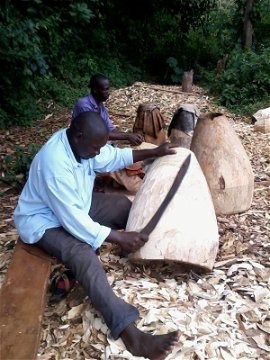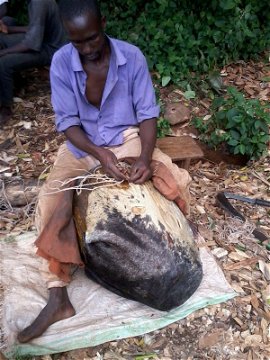Traditional Drums and Barkcloth Experience
The art of making drums here in Uganda has existed for hundreds of years as you will discover while on this tour. Drums where used for communication by our ancestors and specific drum beats where used when there was need to make the community aware of anything that had befallen whether joyful or saddening.
In Buganda kingdom we have a clan that has for centuries had drum making as their main traditional activity. The clan has a responsibility to make special drums that are used during ceremonies where the king is involved for example the drum that the king beats when he graces special events.
Among the drums, we also have those that are common and are used by people in everyday life events, such as traditional marriage ceremonies and other sorts of parties and events. This tour will take you on a discovery journey about how drums are made traditionally, their cultural significance and the does and don’ts all geared towards preserving our culture and norms. We shall visit a workshop where we shall unveil to you our art and sound!
Gallery
Itinerary
History of the bark cloth
The art of Bark cloth making was discovered in Buganda kingdom by a one Lule Ssonko of the Otter clan/totem during the reign of king Kimera 1275 – 1330. The cloth is made out of the bark of Mutuba tree (Ficus natalensis). Before the bark cloth discovery,people of Buganda used to wear animal skins, feathers, leaves and joined small sticks as clothes. The bark cloth spread to kingdoms that surrounded Buganda through barter trade, and these included Bunyoro kingdom, Ankole kingdom,Busoga kingdom, crossing all the way to Tanzania and Zanzibar. In exchange, the Baganda could get salt, wives and traditional money that come in later after barter trade.
The bark cloth is used to make clothes for both males and females,it’s culturally used to wrap dead bodies in Buganda and the surrounding kingdoms, and it was discovered that the cloth naturally sucks out the moisture from the body which makes the body to take longer to decompose. It is used as a bedding, a decorative material, a piece of material to write on/canvas for portraits,a shaver for babies and much more importance.
In 2008, bark cloth making found its way to the UNESO Representative list of Intangible Cultural Heritage of Humanity. The list is made up of those intangible heritage elements that help demonstrate the diversity of heritage and raise awareness about its importance. Taking this tour will have you understand and appreciate ‘innovativeness’ and creativity of our ancestors, not forgetting appreciating the efforts of the current generation in preserving culture.
Village tour
On this tour we visit a village where we shall take you through the art of making a Bark cloth, from how the ‘Mituba’ trees are planted and looked after, how their bark is harvested, and how a bark cloth is made from them. We take you in the field first and later to a workshop, usually close to the home of the Bark cloth maker, in an organized African traditional home. On the tour you also learn about other plants that are medicinal and get a chance to see different types of crops when we take a short visit to atypical traditional garden. It’s an ‘edu-tainment’ tour, come lets show you how unique we are!





Share This Page